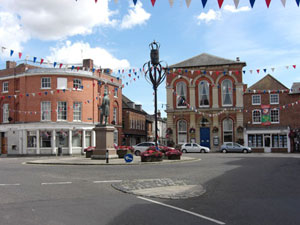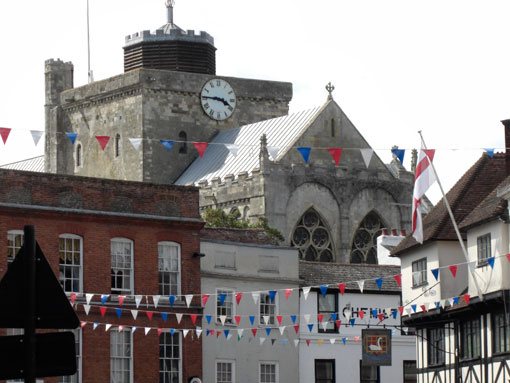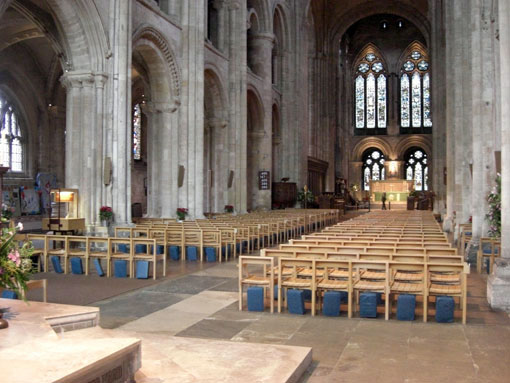| |
|
| |
Description |
 |
 |
|
Romsey Abbey was founded
by King Edward the Elder in 907 for his daughter, Princess Aelflaed,
a nun and the first Abbess of Romsey. Viking soldiers destroyed
the Saxon Abbey during a raid in 994.
Building began on the present day church in 1120 and was finally
completed in 1250. The stone for the Abbey came from Binstead
on the Isle of Wight and was floated across the Solent on barges
and then overland by ox cart. The oak timbers came from the
New Forest.
It now stands as the largest parish church in the county with many interesting artifacts on display.
Among the notable burials are; Princess Aelflaed, Abbess of Romsey,
d.959, Prince Edmund of England, d.971 and in recent times, Earl
Mountbatten of Burma, who lived locally at Broadlands House.
Prince Charles often visits the tomb.
|
|
| |
| |
Open |
 |
|
All year daily, 7.45am to
6pm (Sunday 11am)
Guided tours are available on request.
|
|
| |
| |
Contact |
 |
|
|
| |
| |
More pictures |
 |
|
 |
Romsey |
|
 |
Romsey Abbey:
Earl
Mountbatten of Burma, who lived locally at Broadlands House |
|
 |
Romsey Abbey:
Interesting artifacts on display
See text below about the head of hair. |
|
On October 17th 1839, when grave diggers were working in Romsey Abbey, a coffin was detected five feet below the church floor. The coffin appeared to have been sealed below the foundations of an earlier church which is now believed to be the 10th century Saxon Abbey.
The coffin, which was estimated to weigh 200 lbs, consisted of three sheets of folded lead which had been welded without solder. It contained an inner wooden coffin which was described as sound and compact and the wood could be recognised as oak. The dimensions of the lead coffin were eighteen inches wide at the head twelve to thirteen inches wide at the foot and fifteen inches deep, with a total length of five feet. The lid, a single sheet of lead, was held down by several iron nails driven into the wooden inner coffin.
Inside the coffin was an outline of a body seen as a slight black incrustation: the bones were reduced to a small quantity of dust. The most remarkable thing in the coffin was the head of hair, complete with plait described as being ‘matted together like a peruke newly sent from the wig-makers'. The scalp rested on an oak pillow which had a notch cut into it to keep the head in an upright position.
A glass case was made to contain the scalp and the oak pillow, and they have remained in this ever since. The coffin was later sold for scrap and the wooden inner coffin cut up, probably for curios. The only remaining relics of the burial are the oak pillow and the scalp.
The coffin may have been Roman but all the indications are that it is of middle to late Saxon date (AD 650- l066). There are a number Saxon burials in lead coffins known, all of them seen to have been of wealthy people, either members of royal families or ecclesiastics. The Romsey burial may well have been both as there are strong links between the Abbey and the Saxon royal house of Wessex. It is possible that the gravediggers found the grave of either St. Elfleada or St. Merwenna. Modern techniques may well show that the burial belongs to their era. |
|
| |
| |
Directions |
 |
|
| Junction 13 on the
M27 and follow signs to Romsey or by train to Romsey station. |
|
| |
| |
Parking |
 |
|
|
| |
| |
| |
 |
| |
|
|
 |
| |
 |
 |
|
|
| |
|
|
| |
|
|
| |
| |
| |
Accessibility |
 |
|
 Disabled
facilities are available. Disabled
facilities are available. |
|
| |
| |
More
info |
 |
|
| There are concerts
throughout the year, as well as lunchtime recitals. See abbey website for
details. |
| Across the road from the abbey is King John's House & the Romsey Heritage Centre open
Monday to Saturday, 10am to 4pm all year round, (Adult £2.50,
Concession £2, accompanied child 50p). Entrance to
the Garden is free. The Victorian museum is equipped with a disabled
visitors toilet and a platform lift. |
|
| |
| |
| |
| |
| |
| |
| |
| |
| |
| |
| |
| |
| |
| |
| |
| |
| |
| |
| |
| |
| |
|



